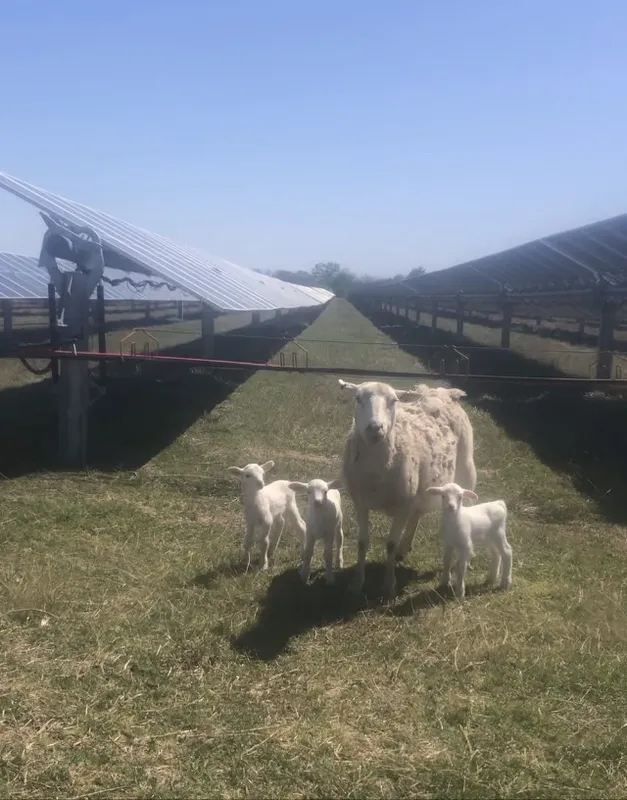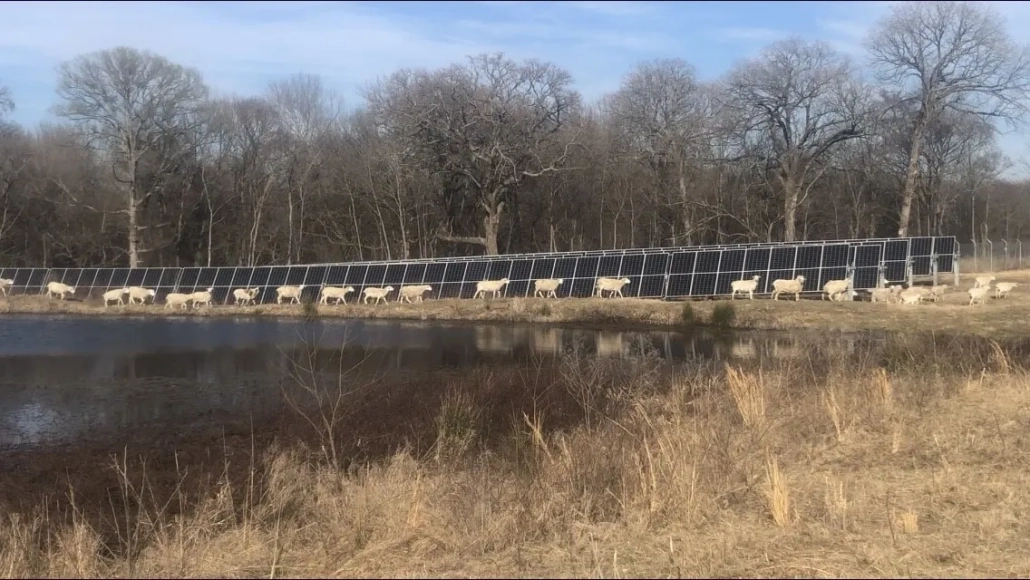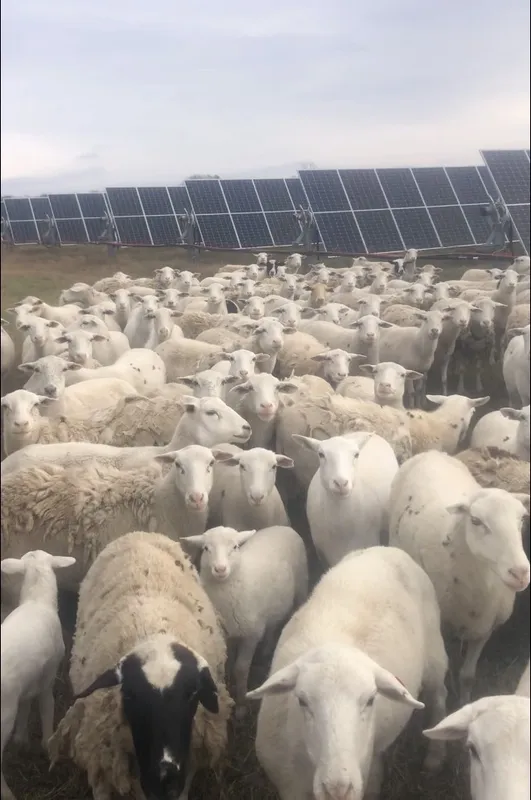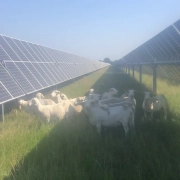Case Study: Texas Solar Sheep
In partnership with Lightsource BP, Texas Solar Sheep grazes over 1,800 sheep on a solar site in Deport, Texas. These sheep are grazed in groups of 50 to 75, 250 to –270, and even 500, making Texas Solar Sheep one of the largest Agrisolar grazing operations in the United States.
All 1,800 sheep are grazed and managed on one solar site, which has 18 individual pastures. The sheep are grazed year-round on the same site. The area gets maybe one snowfall a year, which is not a huge issue for them, as the solar panels provide good protection from elements for the sheep. The farm may buy one stockpile of hay for the winter if they feel it is necessary as a precaution, but stockpiling food is not a great concern on this operation.
No mowing duties are required on this site, thanks to responsibly managed, rotational grazing of the sheep. There are many weeds that sheep will not eat, so they must be manually removed. After some time, if those weeds can be removed from the site, then there is no need for mowing or the use of gas or diesel-operated maintenance equipment. Graziers mowed this site four times in 2021 and have not mowed at all in 2022 as of the end of September.
J.R. Howard, owner of Texas Solar Sheep, says it is important for new graziers to know that the client of this operation is the solar site, and the grazier is providing a service to replace mowing on the site. The sheep-grazing service has been shown to provide significant benefits to the solar site, including enhancing the health of the turf, reducing runoff from rainfall, and providing crucial shade relief to both the grasses and the sheep during drought periods like those seen in 2021.

Healthy Turf Prevents Runoff
The site has realized benefits from preventing rainfall runoff as a result of developing healthy turf. There was hardly any runoff after 3 inches of rainfall, due to the enhancement in turf quality from responsible grazing management, according to Howard. Healthy turf is a result of not overgrazing individual areas and managing proper sheep rotation. The sheep are not allowed to eat to the bare ground, resulting in what is known as a healthy turf that allows the land to capture and hold the water when it rains, resulting in less runoff and other associated issues. Howard said the land is back to looking like “normal land” and not “golf courses.”
Shade Relief for Grasses and Sheep
During the drought of 2021, the solar panels provided crucial shading for the grasses and the sheep. The grass between the panels that did not have shade did not do as well as the grasses that were getting shade from the panels. “The shade support really helped a lot,” Howard said.
Sheep typically feed in the morning and then hang out in the shade during the day, which the panels provide plenty of. Unlike goats and cattle, sheep do not damage equipment by rubbing against it, climbing on it, or chewing on wires as some goats do. The sheep can be comfortable under the panels during the day with little, if any, threat of damage to equipment.
Rotational Fencing
One challenge that the operation has dealt with is constantly rotating the sheeps’ pasture, which needs to be consistent and on schedule. Limiting grazing to smaller areas more often, as opposed to one large area less frequently, is ideal. However, this approach requires fencing that must be moved regularly. The operation requires “cross fences” to break large blocks of land into smaller pastures. Moving fences is one of the most consistent tasks of the operation, but it is manageable.

Breeding for Agrisolar Conditions
The solar company allows the sheep owners to breed lambs when they want. The sheep live on the solar site from birth until they are sold or pass away. The sheep are also checked by a veterinarian at various times during their life cycle on the site. Owners breed sheep on site, to “get the ewe they want,” Howard said.
This selective breeding process is an attempt to breed a sheep genetically superior in parasite resistance than previous generations of sheep. These sheep would be specifically resistant to parasites during the lamb phaseand the lactating ewe phases of their life, which are often when farmers struggle with parasites infecting their sheep. Due to the selective breeding process on this site, the sheep will be more resilient to the conditions they experience in Texas, which includes hot temperatures and prolonged, wet conditions.
Although Dorper sheep, which originated in South Africa, are genetically capable of handling hot temperatures, they are being breed with Katahdin and St. Croix to enhance their genetic capabilities further—making them the most ideal sheep for agrisolar operations in these climate conditions.

What New Graziers Should Know
New graziers should know that this is not a grazing lease with the solar company but, rather, a grazing service business. As a service business, people with sheep will have a customer that they are providing a service to. This requires graziers to spend more time on-site where they can correct issues quickly. If sheep get out of the fenced paddocks, graziers can get them back to their assigned areas quickly. Sometimes sheep pass away and need to be removed as quickly as possible. Being on-site allows for that. If sheep are sick, they can be attended to quickly. The grazier can also ensure that sheep have constant access to water.
The solar company also benefits from having Texas Solar Sheep staff on-site regularly. “We are out there more than the solar folks, so we see issues for them, too. It has been an extra set of eyes for them on the solar equipment, so that has been a significant help for them, as well. If they see downed panels, damaged wiring, or even fires, they can report it quickly and get it taken care of,” said Howard. “There is a public eye on this stuff, so we want to make sure we are doing it right.”
Howard stated that grazing is the future of utility-scale solar. It is important that the first few big sites get it right. With great partners like Lighthouse BP, Texas Solar Sheep has been able to scale up its operation, and is planning for larger sites for the future, meaning more sheep on more solar sites.
Howard said the family farm had about 300 ewes and having the opportunity to partner with Lightsource BP has allowed them to have extra land to graze and scale up their operation. “We’re not a big landowner, and this allowed us to scale up a lot, to 1,800 ewes.”



